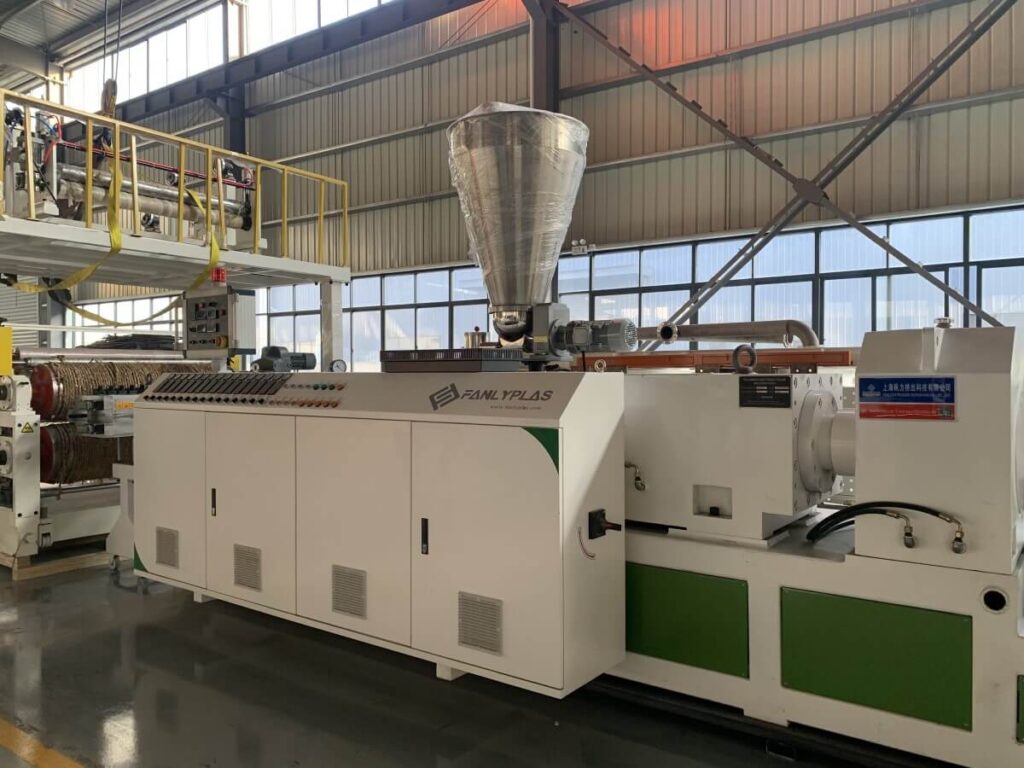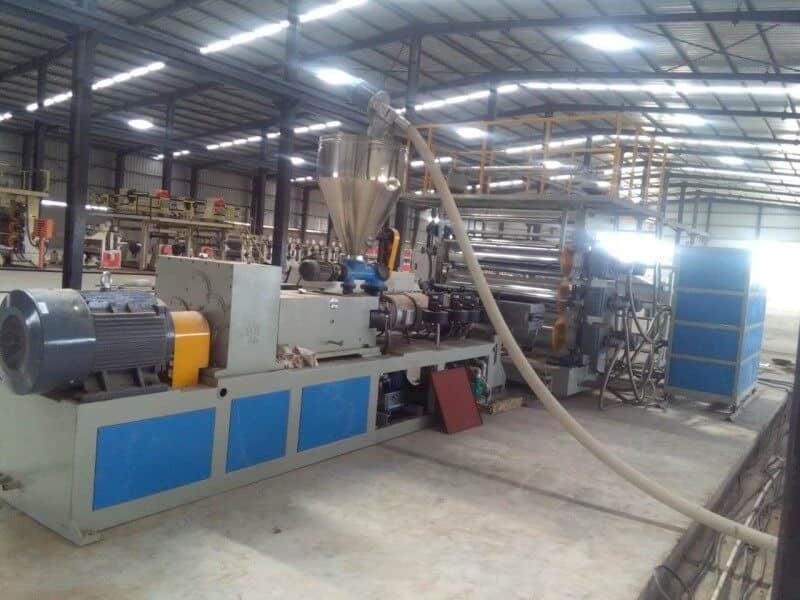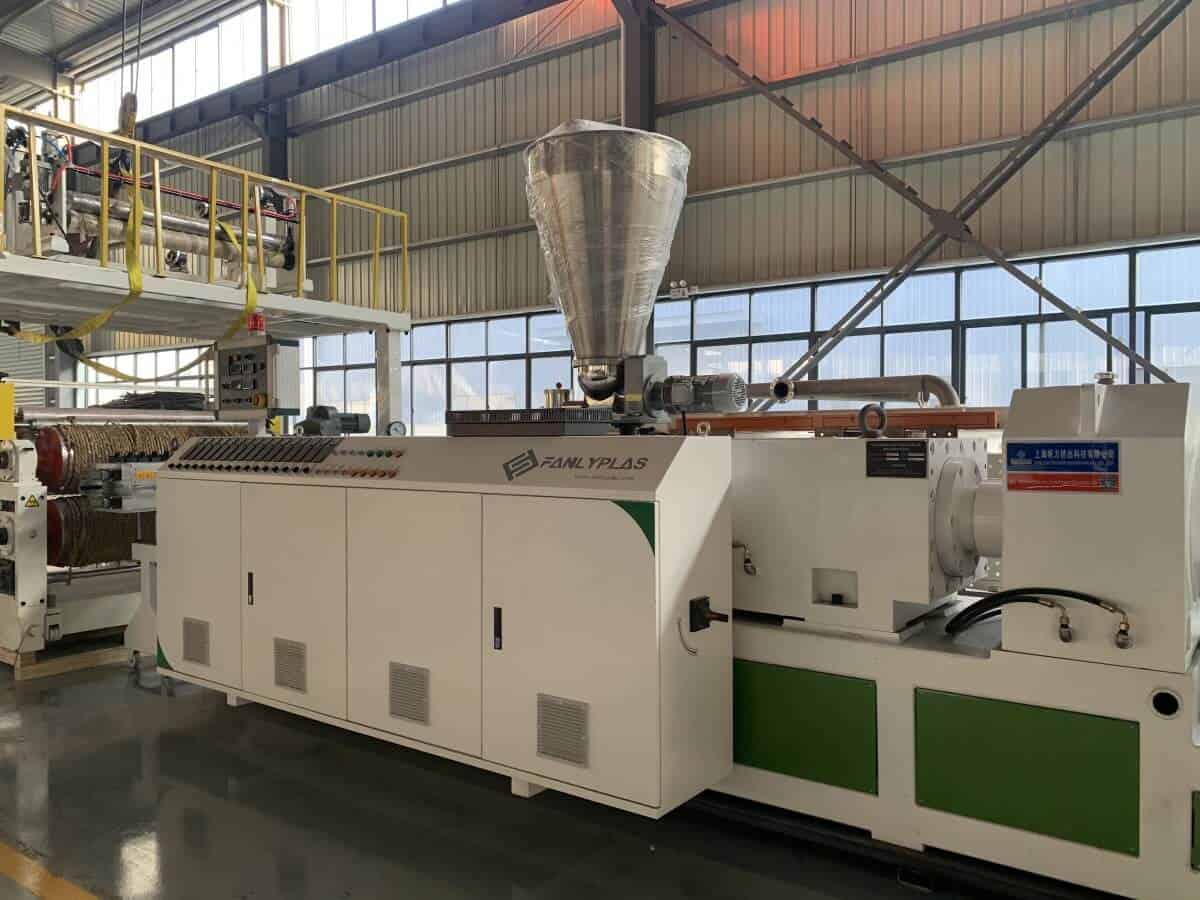Introduction
A wide array of sectors such as construction and manufacturing are now opting for PVC products these days. You need a great plastic sheet extrusion line to make quality PVC products. Plastic products are seen as a good choice over other materials due to their appealing perks. We are talking about their durability, quality, and flexibility. All this is possible thanks to quality plastic sheet extrusion lines. Plastic sheet extrusion lines are huge blocks of machines that are linked and are involved in the production of plastic products. However, during the extrusion process, there is one vital segment that performs a vigorous and critical job, the auto-cutter. This machine is responsible for cutting the plastic sheet into desired measurements for a particular application.

How the Plastic Sheet Extrusion Line Cutting Machine Works
Extrusion cutting is a vital process that involves sizing and shaping the products in plastic sheet extrusion lines. Therefore, the type of cutting equipment needs to be a top-notch and reliable one. It will in turn ensure one gets precise plastic sheets that have minimal to zero error margin. There are tons of such cutting machinery out here that can be linked to the plastic sheet extrusion line. However, not all cutting tools offer excellent and remarkable results. Only a drop in the ocean meets all the necessary set standards. When shopping for one, you need to have an eye to detail and pick on the perfect machine that will not disappoint. It might not be easy as it seems. That is why this publication is dedicated to guiding you.
Therefore, a set of guidelines needs to be there that will take you through picking nothing but the best. No one ever wishes to shop for a piece of machinery that will disappoint and be a regrettable choice.
To make things easier for our customers, we have listed some of the factors you need to consider every time you think of getting the perfect cutting machine for your plastic sheet extrusion machine:
1. Precision cutting
Precision cutting is the most sort-after factor that many would wish for when looking for a plastic sheet extrusion line. Of course, no one would wish for a cutting machine that produces plastic sheets or any other PVC materials that are poorly cut and the cuts are rough, and have wrinkles.
Plastic sheet extrusion lines with high precision cutting machines offer the best cutting experience. Such a machine provides secondary cutting or finishing done perfectly to eliminate material waste. At the same, the quality of the finished product is upheld. Consistency in the cutting precision is also a plus when picking in an extrusion cutting machine.
2. Quality
This is an obvious requirement any time you are shopping for something. Now that you are dealing with products that need to be properly made so that quality is upheld, you need a cutter that enhances that as well. Getting a cutter that cuts nice and maintains the value of a given material such as a plastic sheet is something to smile about. At the end of the day, the end-user customers are after products that are made to perfection and with quality materials and processing.
Since cutters play a crucial role in plastic sheet extrusion lines, you must ensure that you use a quality cutter with a perfect cutting blade and any other accessories involved. Quality cutting machines are also meant to last for the longest time possible and not break easily or after a short span of use. On top of that, quality cutting machines show extra abilities to work even in hard situations without struggling so much. Therefore, when one spends their hard-earned cash trying to purchase one, the value of money is preserved.
3. Flexibility and ease when using
A flexible machine can run in different numerous events that are not specifically assigned to it. On the other side, you must consider a plastic sheet extrusion line cutting machine that is easy to use. An extrusion machine is usually a complex machine with many components linked together and all work for a common purpose. Therefore, an extrusion cutting machine that is part of the entire extrusion machine needs to be easy to use and control. This will increase workflow and makes the extrusion production line move smoothly.

Different types of extrusion cutters
a. Fly-knife cutters
Moving in a slicing or chopping motion, this type of cutting machine is well known and commonly used by plastic sheet extrusion line cutting machines. The Fly-knife machine comes fitted with one or two blades. It is applied in the cutting/chopping of small and softer plastic sheets and other light-density materials. The blade or blades linked to the machine are usually connected on a flywheel that rotates hence producing inertia force that aids a lot in the cutting process. The fly-knife cutter is powered by an electric motor mounted in the machine that is paired to a series of planetary gears that increases the speed and cutting force.
The gear also acts as a shock absorber to the motors and their components and also increases torque supply. This extrusion cutting machine works by a displacement mechanism. The displacement mechanism works by pushing the cut materials to one side and leaving the other aside uncut. It is a continuous process that saves material in the end. This process is effective and saves time as well. To the plastic sheets that are thin, soft, and small, the fly-knife cutter passes through them in only a single cut.
For a high-performing cutter such as this one to perform its function well and cut precisely there must need to prevent all the vibration and shakings that come along. Stability is key during the cutting process as it produces extremely accurate cuts. Hence, the cutting blades come fitted with bushings on both ends to promote stability and rigidity.
Fly-Knife Cutter Issues in Plastic Sheet Extrusion Lines
Angle hair
Also going by “fines”, these are fine materials that are produced while the fly-knife is in operation. It can be termed as wastage and needs to be avoided. It mostly happens when you try to cut soft PVC foam boards or any other products. The remedy to that problem is to heat the cutting blade while it’s in position. You can install secondary equipment and accessories on the cutting machine that will heat the blade so that you can avoid losing so much of your material.
Also, remember to add extra temperature controllers that will regulate the temperature of the blade depending on the type of material you are cutting.
Clumping of material on the blade
This is another frustrating issue that is common with fly-knife cutters. It happens in most instances when the cutter is cutting through soft and thick or gummy materials. They tend to stick or clump off the blade as it is cutting and in turn reduced the blade’s functionality. That is the cutting speeds reduction and ineffective cutting.
You will notice material beginning to form up on the blade just a few hours when the machine begins operation. Material clamping does not pick on a specific type of blade. Even the most-sharpest blade can become a victim. You have to understand that there is no set solution to this menace.
All you can try is first to use a wetted piece of clothing to wipe out any sticky material off the blade. You can do that after a set number of revolutions. You also have to use an alcohol-based solution to dip in the wiping cloth. This is just to increase the chances of effectiveness. On top of that, you can modify a mechanical or electrical spray and wipe sort of equipment that uses isopropyl alcohol to clean the blade.
The wiping and spraying do not only secure your blade from clamping but also nearby accessories such as bushings, drip trays, and cutting chambers. It also reduced the frequency of cleaning the machine regularly by hand.
Bushings extrudate clump
It is normal for any sort of extrudate to stick and clamp-on any surface it comes in contact with. Sticking extrudate on the bushings is a huge problem since it entire affects the whole production line. It affects consistency and at the same time reduces the quality of the material.
b. Planetary cutters
Planetary cutters are the most efficient and sophisticated types of cutters you can ever think of. They ensure the material under them is properly cut with zero distortion and is particle-free. If you plan on getting a cutting machine that performs nice and cuts high-quality cuts, then look no further. Planetary cutting machines have such immense power and ability to cut through plastic material of the highest densities and rigidity without struggling.
The cutting blade of the planetary cutting machine comes in a circular design and is fixed on a rotating ring. Mostly applied in cutting PVC tubings, this type of cutting machine works by spinning the rotation ring to very high RPMs and cutting through the circumference of the tubings until it is all split apart. Planetary cutting machines are usually mounted on moving tables since they are flexible and can be used to make square cuts.
c. Guillotin cutters
These are specially made vertical cutters that cut or slice downwards on any given extrudate. They are the best option between the fly-knife cutters and the saw cutters since they cut through materials easily and smoothly. The cut is always slow and careful and performs incredibly well on sticky extrudate. Small diameter material is a great option when using the smaller Guillotine cutters while the large diameter materials need to be cut by a Guillotine machine that is fixed on a moving table.
d. Saw cutters
When choosing a machine that can cut through very hard and rigid plastic materials that are brittle and thick, then the Saw cutters should be the number one option. They always come in a large circular design that does an amazing job, especially on plastics. However, there is always a challenge when using this type of cutter on moving extrudate. To get the best results on moving extrudate material, you need to attach the Saw cutter to a moving table to get straight and perfect cuts. At the same, you need to make sure that the set speed of the blade is the same as the extrusion line speed. This will enhance uniformity when in operation.
Another challenge faced when using this material is too much dirt and sawdust produced. A vacuum cleaner needs to be attached to the machine that collects all the debris that comes out as the cut is being made.
The cutting tools above are among the best and most reliable ones you can ever come across. Shopping and purchasing one is always a memorable affair and a sigh of relief especially when you are used to a problematic machine. But now while you are using the machines, you might come across one or two problems. This is obvious and should be expected of any sort of machinery within us. Therefore, you must know how to handle and tackle any issue coming your way.
Saw Cutter Limitations
The limitations that each cutting machine poses shouldn’t frighten you at all because there is always a way to troubleshoot and solve the problems. They are as follows:
Irregular/Uneven cuts
The saw cutter/traveling saw cutters have a common problem and that is “burrs” or making rough cuts. One of the main culprits that create this problem is usually the specific blade used or the speed of the cutting machine’s motor. If your saw cutter cutting speed is variable or changeable, then to get the optimum cutting results that are free from burrs, you need to adjust the speed. You may perhaps want to set the speed higher. However, be keen when setting speeds since it does not work on all sorts of materials. For materials that are soft and lenient, you need to set the speeds to faster whereas, for materials that are thick and hard, the speeds need to be set lower.
On the other side, you can get a cutting machine that has a fixed speed on its motors. To get the best results, you need to opt for a faster motor or change the type of blade you are using. Depending on the type of material you are cutting, you need a wide array of blades that can be fixed during operation.
Cut-length issues
Cut-length intolerance is common, especially with saw cutters that are old and attached to moving tables. The old standard moving tables are usually a bit difficult to adjust to the correct speeds as the extrusion line. This limitation poses a huge challenge when trying to get the best and most accurate cuts. During operation with the standard saw cutters, air pressure also causes problems. Its fluctuation hinders accuracy and uniformity. In most instances, after the cutting is done, one needs to perform a secondary cutting process to enhance and perfect the cuts. To get rid of this menace, people are now opting for servo-controlled Saw cutters.
This types of saw cutter are unique and arguably the best. They are easily adjustable and can trace the extrusion line speed, therefore, providing precise and top-notch cutting.

Solving Cutting Machine Problems
Square cut variation
When trying to cut an extrudate in a square shape, the saw cutters mess things up a bit. To get a perfect square cut, proper clamps and experience will be necessary when using the Saw cutter. Below are common methods you can apply to get rid of the problem;
i. Equip air-feed bushings
The best remedy to avoid sticky extrudate from building up on the cutter bushings is to try air-feed bushes. They work by emitting a stream of the pressure of lubricant that makes either plastic sheets or any sticky material slide through easily.
ii. Use line cutter bushings
Line cutter bushings can also work perfectly well as they also allow for a smooth and easy movement of the extrudate over the bushings. They are specially designed to allow for clearance of ¼ or ½ inch space between the material and the steel sleeves.
iii. Lubricants
There are specially made cutters that come fitted with their own storage spaces for lubricants. These lubricants are sprayed out with help of air pressure and onto the holes on top of the cutter bushings. To get the perfect result, you are advised to pick on an alcohol-based lubricant. This works magic!
Material cracking
There is nothing worse than end products of an extrusion line coming out with lots of faults. One of the many faults that are caused by the Fly-knife cutter specifically is the cracking of the material. Breakaway cuts are very common especially when slicing through rigid or semi-hard plastic sheets. Unfinished cuts, cracks, and rough endings occur the most and are truly heart-breaking. This leads to piling up of rejects and extra work hours spent on secondary finishing or entirely redoing the extrusion process. Here are some common means you can apply and get the problem solved;
i. Cut extrudate while still hot
This is an impressive solution to cracking and chipping since it is perfect. Casting the rigid or semi-rigid product into the cutter causes a lot of racks. However, casting fresh extrudate that is still hot reduces the chances of cracking or chipping. At temperatures of about 120-140F, you are then supposed to bring the extrudate onto the cutting table. Cutting a material that has retained heat works well compared to preheating it and then cutting. Either way, cutting a material that is still warm reduces the chances of it cracking and breaking.
ii. Regulate and monitor the speed of the blade
Doing so works pretty fine in most cases. Speed matters a lot and is one factor that is behind the cracking and breaking of plastic products. Therefore, you must be extra vigilant on the cutting speed and depending on the type of material being cut. Soft material needs to be cut at a very high speed while hard or rigid material needs slow cutting speeds.
iii. Planetary cutter issues
This type of cutter is probably one of the finest and most error-free tools you can ever think of. It is only through the planetary cutter that secondary finishing can be avoided and also piling up of rejects can be reduced. It is because the machines cut extremely precisely with zero to minimal issues.
Planetary cutters have very few limitations. They included; Expensive and costly to purchase and maintain and they do take longer to cut through materials.

FAQs About Plastic Sheet Extrusion Machine Cutters
1. How long should one need to change to a new plastic sheet extrusion line cutting machine?
There is no set period that one needs to keep their plastic extrusion cutting machine. However, when the machine begins getting old problems to come in a lot. It happens often especially if you don’t take extra care of the machine. At the same time, you can purchase a poor-quality machine that of course won’t last. To get rid of the problem, we at FANLYPLAS have decided to deliver exceptional and out-of-the-ordinary cutting machines. These are quality machines guaranteed to be in good shape for the longest time possible.
2. What are some of the maintenance tips for an extrusion cutting machine?
An extrusion cutting machine needs extra maintenance if you wish to see it run and feel as new for long. Below are some of the methods you can apply;
Frequent cleaning- After the machine is in operation for a while, it is wise to clean it off from dirt and debris. Vital parts need specially designed cleaning tools.
Frequent check on the machine while is in operation- You also need to check on the machine regularly to ensure that it is performing well. You will also be able to notice any problems with the cutting process and halt the extrusion line if need be.

Conclusion
Cutting machines are important components in the plastic sheet extrusion line. Before you plan on shopping for one, you must ensure you have followed the above tips for the latter. Not only will you get a quality cutting machine but one you can utilize for the longest time. Here at FANLYPLAS, we are dedicated to serving you with custom-made cutting machines or an entire plastic sheet extrusion line. Our products are way up from ordinary cutting machines and a great value for your money. Get in touch with us and get the cutting machine you have been longing for.



